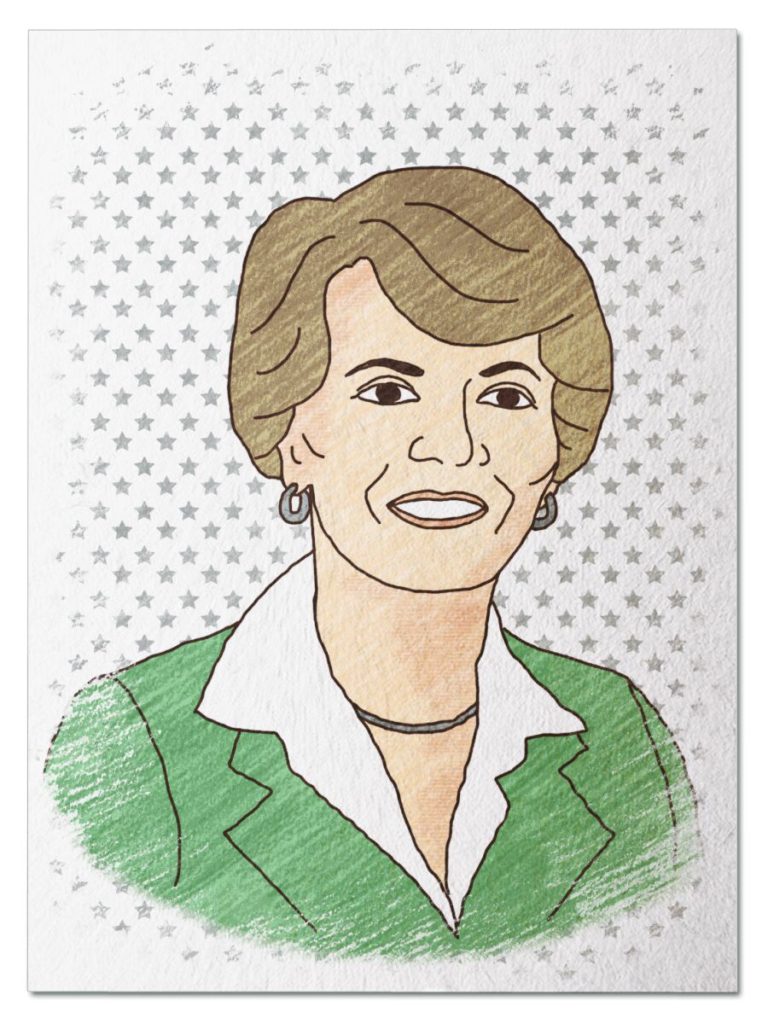
Passionate Patriot
She was inspired by her widowed mom’s determination and work ethic to create a meaningful life for herself. She began her career as a public school teacher by day and law student by night. Her experience as a special victims unit prosecutor protecting New York’s most vulnerable citizens motivated her to run for office at a time when women were hard to find in the halls of Congress. Her political skill, charm, and integrity were a powerful combination that led her to be the first woman vice presidential candidate for a major American political party. Walk onto the stage at the 1984 Democratic National Convention and make history with Geraldine Ferraro…
Her Ruby Shoe Moment
The Power of the Wand
Her Yellow Brick Road
Brains, Heart & Courage
Glinda’s Gallery
Just the Facts
Her Ruby Shoe Moment

Gerry accepting the Vice Presidential nomination at the Democratic National Convention (AP).
Geraldine Ferraro walked onto the stage at San Francisco’s Moscone Center on the last night of the 1984 Democratic National Convention. She looked out into the faces of the thousands of people who had joined her in this historic moment. She had never experienced anything like it. Many male delegates had given their floor passes to women, and the majority female crowd was on its feet. The choir of cheering and clapping and the sea of signs bearing her name, both official and homemade, were almost overwhelming. She was wearing suffragette white in honor of the women who had fought for the 19th Amendment. Gerry knew this moment belonged to them as much as it belonged to her.
It had been a whirlwind of a week. It was only 8 days earlier that Walter Mondale, the Democratic nominee for President, had asked her to be his running mate. Gerry was one of several politicians, men and women, who Walter had interviewed. While Gerry had enjoyed their conversation, she left believing he would ask someone else. His team wasn’t sure they should gamble on a woman. It had never been done before, and they had no idea whether it would attract or repel voters. Some advisors worried it would look like Walter was caving to “special interests” and tried to talk him out of it. But Walter disagreed, later reflecting that “I thought that putting a woman on a major-party ticket would change American expectations, permanently and for the better.”
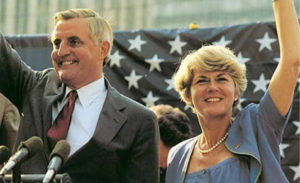
Gerry with Walter Mondale on the campaign trail (Library of Congress, US News & World Report Collection).
When Walter called, Gerry was working in her San Francisco hotel suite. She went into the bedroom to take the call privately, leaving her staff in the common area on pins and needles. When she walked back out, she smiled and asked them: “how does it feel to be a part of history?” Everything since that moment had been a blur. She had immediately packed for a late night flight to Walter’s home state of Minnesota, where they announced the news to assembled reporters in the state’s capital the next day. Walter declared “I looked for the best vice president, and I found her in Gerry.” They spent the next day at a rally in Walter’s Southern Minnesota hometown, and then Gerry got to work writing her convention speech.
Gerry realized that she was embarking on an uphill battle. The economy was booming and President Reagan was already up 19 points in the polls. But the enthusiasm of the crowd made her believe anything was possible. After nearly 2 minutes of cheering, Gerry began speaking. She had to say “Ladies and Gentlemen of the Convention” three times before the crowd quieted. She got in one line: “My name is Geraldine Ferraro” before the crowd erupted in applause again. She pushed forward, saying:
I stand before you to proclaim tonight: America is the land where dreams can come true for all of us. As I stand before the American people and think of the honor this great convention has bestowed upon me, I recall the words of Dr. Martin Luther King Jr., who made America stronger by making America more free. He said: “Occasionally in life there are moments which cannot be completely explained by words. Their meaning can only be articulated by the inaudible language of the heart.” Tonight is such a moment for me. My heart is filled with pride.
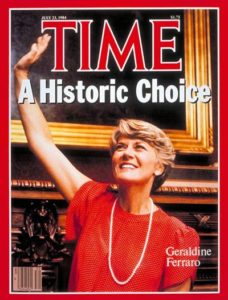 She paused, knowing that her next sentence was the moment the women in the audience and around the country had been waiting to hear. “My fellow citizens, I proudly accept your nomination for Vice President of the United States.” It was another minute before she was able to speak again, because the crowd resumed its cheering, including the chant “Ger-ry Ger-ry.”
She paused, knowing that her next sentence was the moment the women in the audience and around the country had been waiting to hear. “My fellow citizens, I proudly accept your nomination for Vice President of the United States.” It was another minute before she was able to speak again, because the crowd resumed its cheering, including the chant “Ger-ry Ger-ry.”
Gerry’s speech focused on the common values Americans share, whether they live in a small town in rural Minnesota or a busy urban neighborhood in New York City. She emphasized the importance of fair play, education, and opportunity for all. And her pledge to continue working to get the Equal Rights Amendment ratified sparked a chant of “E-R-A! E-R-A!” As the crowd quieted, Gerry ended her 30 minute speech with a solemn promise: “To all the Children of America, I say, the generation before ours kept faith with us. And like them, we will pass on to you a stronger, more just America. Thank you.”
The Power of the Wand

1984 Campaign Button (Wikimedia Commons)
Gerry became famous overnight. Letters poured into her congressional office at the rate of 2000-3000 per day. The Mondale/Ferrarro ticket enjoyed a “convention bounce” in the polls. People wanted to see her, with 12,000 showing up to her first rally. But in the end, the economy and President Reagan’s popularity held. The Republicans won in a landslide.
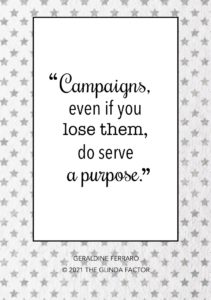 Gerry’s candidacy sparked greater engagement for women in politics, not just as candidates but as voters. But it took another 24 years until a woman occupied a top spot on a major party ticket. Sarah Palin became the first Republican Vice Presidential female candidate, running with John McCain in 2008. And then it was another 12 years before Kamala Harris joined Joe Biden as his running mate. But this time, the woman was on the winning ticket, and America’s first woman Vice President will take office on January 20, 2021.
Gerry’s candidacy sparked greater engagement for women in politics, not just as candidates but as voters. But it took another 24 years until a woman occupied a top spot on a major party ticket. Sarah Palin became the first Republican Vice Presidential female candidate, running with John McCain in 2008. And then it was another 12 years before Kamala Harris joined Joe Biden as his running mate. But this time, the woman was on the winning ticket, and America’s first woman Vice President will take office on January 20, 2021.
Who will be next? Take a look at the New York times article “She’s 16 And Wants to be President: Meet the Teenagers Planning Their Campaigns” for some contenders. And check out the group IGNITE, an organization devoted to encouraging girls to become the next generation of political leaders. IGNITE sponsors programming and conferences for girls to learn about government, how to voice their opinions to policymakers, and how to run for office.
Her Yellow Brick Road

Gerry as a Congressional candidate with President Carter (White House Staff Photographer Collection).
When Gerry decided to run for Congress in 1978, she faced an uphill battle. The Queens, NY district she lived in was politically and ethnically diverse, leaned conservative, and had never elected a woman Representative before. But Gerry’s experience as a prosecutor had taught her that good policy needed to combine liberal and conservative values: empathy for the vulnerable and consequences for those who broke the law. She chose the campaign slogan “Finally A Tough Democrat” and won, becoming one of just 24 women in Congress (22 in the House and 2 in the Senate).
Gerry prioritized her constituents over her party, and if her constituents strongly supported a conservative law, she listened. Even so, she rose through the Democratic ranks quickly, as her political skills impressed the Speaker of the House. She served on the Public Works & Transportation Committee, Post Office and Civil Service Committee, and the Select Committee on Aging. She was invited to introduce the keynote speaker at the 1980 Democratic National Convention. By her third term, she was given a coveted spot on the powerful Budget Committee.

Gerry’s Ninth District Report (Wikimedia Commons).
Gerry was passionate about empowering women so they wouldn’t be vulnerable to exploitation and abuse. She sponsored the Women’s Economic Equity Act in 1981, which made it possible for housewives to open their own retirement plans and protected the pension rights of widows and divorced women. She also was part of a team working to resurrect the Equal Rights Amendment.
When a 1983 Gallup poll revealed that 80% of Americans would vote for a qualified woman for President, the National Organization for Women asked all six Democratic men running for the 1984 Presidential nomination whether they would consider choosing a woman as a running mate. They said yes, and a group of women activists, known as “Team A,” decided to do everything they could to make it happen.
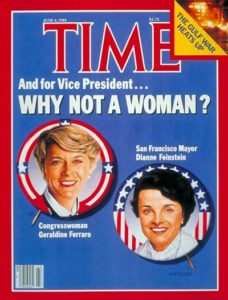 Team A made a list of Democratic women politicians and debated their qualifications. Gerry stood out, as both a working mom and a liberal who had good relationships with her conservative constituents. Once Team A chose Gerry, they had to persuade her to give up her House seat and take a chance on doing something that had never been done before. They invited Gerry to join them for a casual dinner of takeout Chinese food. For dessert, they passed around fortune cookies with custom messages. Gerry pulled the fortune from her cookie and read it out loud: “You will win big in ’84.”
Team A made a list of Democratic women politicians and debated their qualifications. Gerry stood out, as both a working mom and a liberal who had good relationships with her conservative constituents. Once Team A chose Gerry, they had to persuade her to give up her House seat and take a chance on doing something that had never been done before. They invited Gerry to join them for a casual dinner of takeout Chinese food. For dessert, they passed around fortune cookies with custom messages. Gerry pulled the fortune from her cookie and read it out loud: “You will win big in ’84.”
Once Gerry said yes, Team A got to work. They lobbied influential Democratic politicians on Gerry’s behalf. They helped Gerry become the first woman to chair the Democratic platform committee. This was a tough job, as she had to synthesize the often competing priorities of the party into one document representing its positions for the 1984 election. Gerry gained helpful insight into the inner workings of national politics and increased her visibility just as Democratic nominee Walter Mondale started his search for a running mate.
Brains, Heart & Courage
Gerry grew up in an Italian-Catholic family in Newburgh, New York. Her dad and her maternal grandparents were Italian immigrants. She was named after her older brother Gerard, who died in a car accident before Gerry was born. Her early childhood was a happy one, but tragedy struck again when Gerry was 8. Her dad was arrested on charges of illegal gambling and died of a heart attack the day of his trial. Her mom moved the family to Queens, where she supported the family through working long hours as a seamstress.
 Gerry admired her mom’s work ethic so much that she was inspired to work hard too. She skipped three grades and graduated from high school when she was just 16. She went to Marymount Manhattan College on a scholarship and met a boy named John Zaccaro there. After graduating in 1956, Gerry worked as a second grade teacher in a Queens public school and enrolled in Fordham Law School in Manhattan, where she was able to attend classes at night, after work. Gerry was one of only two women in her 1960 graduating class.
Gerry admired her mom’s work ethic so much that she was inspired to work hard too. She skipped three grades and graduated from high school when she was just 16. She went to Marymount Manhattan College on a scholarship and met a boy named John Zaccaro there. After graduating in 1956, Gerry worked as a second grade teacher in a Queens public school and enrolled in Fordham Law School in Manhattan, where she was able to attend classes at night, after work. Gerry was one of only two women in her 1960 graduating class.
When Gerry and John got married, Gerry decided to keep her last name professionally. Ferraro means “iron” in Italian, and Gerry wanted to honor her mom’s strength and sacrifice. Gerry worked part time as a civil lawyer for John’s real estate firm while their three kids were little. Her first election was in 1970, for president of the Queen’s County Women’s Bar Association. She won.
Gerry returned to work full time when she joined the Queens County District Attorney’s Office as a 38 year old rookie prosecutor. She started the Queens Special Victims Bureau, which specialized in prosecuting violent crimes against vulnerable victims. Through this work, Gerry observed that domestic violence and poverty were a root cause of many of these crimes and decided to run for office to be a voice for change.
Glinda’s Gallery
Just the Facts
- Gerry was born on August 26, 1935 in Newburgh, New York.
- Gerry and astronaut Sally Ride developed a strong friendship during the 1984 election. Sally had become famous the year before when she became the first American woman in space. Gerry referenced Sally in her Vice Presidential acceptance speech, observing that “change is in the air” for women. Sally was touched by the mention, reflecting that as she watched Gerry’s speech, “for the first time, I understood why it was such an emotional experience for so many people, to see me accomplish what I had, as a woman.”
- Soon after the Convention, national newspapers started running stories about John’s real estate business, creating immense pressure for him to release his tax returns. When he did, Gerry held a press conference where she answered questions from over 250 journalists for two hours. The Reagan campaign had two aides dedicated to searching John’s returns and feeding negative stories to the press. Some reporters began hinting that John was connected to organized crime, which Gerry believed was due to ethnic bias because of the media focus on their Italian-American heritage. The allegations weren’t true, but the excess scrutiny caused some minor legal trouble for John and took some wind out of the campaign sails.
- The Vice Presidential Debate against George H.W. Bush was another first. Gerry felt pressure to perform well, both for the campaign and on behalf of all women. She was nervous about foreign policy, as it was her weakest topic while Bush had been CIA Director and U.S. Ambassador to the United Nations. Gerry studied for weeks, helped by Madeline Albright (who later became the first woman Secretary of State!). Bush deliberately referred to her as Mrs. Ferraro instead of Congresswoman Ferraro. And he tried to make her look weak, at one point offering to “help” her understand the difference between Iran and the embassy in Lebanon. Gerry pushed back, saying “I almost resent, Vice President Bush, your patronizing attitude that you have to teach me about foreign policy.”
- Gerry was both amused and frustrated by the questions some reporters thought were appropriate to ask a woman candidate. Questions ranged from whether she could bake a blueberry muffin to whether she would be strong enough to push the nuclear button.
- After the 1984 election, Gerry stayed involved in politics. She was a fellow at the Harvard Institute of Politics from 1988-1992. She ran for Senate twice in New York, in 1992 and 1998. During the Clinton Administration, she served on the United Nations Human Rights Commission and was a delegate to the Fourth World Conference on Women. She also served on the Board of the National Democratic Institute of International Affairs and the Council on Foreign Relations.
- In 2007, Gerry’s alma mater, the Fordham University School of Law named a rose after her “in recognition of her courage and grace and commitment to public service” The school planted the Geraldine Ferraro rose on their Lincoln Center and Rose Hill campuses.
- Gerry wrote three memoirs. The first was Ferraro: My Story, the rights to which she sold for $1 million. The other two were Changing History: Women, Power & Politics and Framing A Life: A Family Memoir.
- The Eleanor Roosevelt Legacy Committee awarded Gerry its Pioneer in Politics Lifetime Achievement Award in 2008.
- Gerry died on March 26, 2011 of multiple myeloma. She had lived with the disease for 11 years.
Want to Know More?
Ferraro, Geraldine & Francke, Linda Bird. Ferraro: My Story. (Bantam Books NY 1985).
Zaccaro, Donna. Ferraro: Paving the Way (Dazzling Media, LLC 2014).
Staff.”Geraldine Ferraro” (Fordham University Hall of Fame).
Staff. “Ferraro, Geraldine Anne.” (History Art & Archives U.S. House of Representatives).
Staff. “Button, Geraldine Ferraro, Sally Ride” (Smithsonian National Air & Space Museum).
Thulin, Lila. “The Woman Who Paved the Way” (Smithsonian Magazine Aug. 10, 2020).
